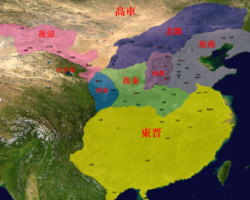Later Liang (Sixteen Kingdoms)
| Later Liang (後涼) | ||||||||||||||
| 酒泉 (387-389), 三河 (389-396), 涼 (396-403) |
||||||||||||||
|
||||||||||||||
|
Map of Sixteen Kingdoms showing Later Liang in pink colour.
|
||||||||||||||
| Capital | Guzang | |||||||||||||
| Government | Monarchy | |||||||||||||
| Tian Wang | ||||||||||||||
| • | 386-400 | Lü Guang | ||||||||||||
| • | 400 | Lü Shao | ||||||||||||
| • | 401-403 | Lü Zuan | ||||||||||||
| • | 403-406 | Lü Long | ||||||||||||
| History | ||||||||||||||
| • | Established | 386 | ||||||||||||
| • | Lü Guang's claiming of imperial title | 396 | ||||||||||||
| • | Southern Liang's and Northern Liang's independence | 397 | ||||||||||||
| • | Disestablished | 403 | ||||||||||||
| • | Lü Long's death | 416 | ||||||||||||
|
||||||||||||||
The Later Liang (simplified Chinese: 后凉; traditional Chinese: 後凉; pinyin: Hòu Liáng; 386-403) was a state of the Sixteen Kingdoms during the Jin Dynasty (265-420) in China. It was founded by the Lü family of the Di ethnicity.
All rulers of the Later Liang proclaimed themselves "Heavenly Prince" (Tian Wang).
...
Wikipedia

